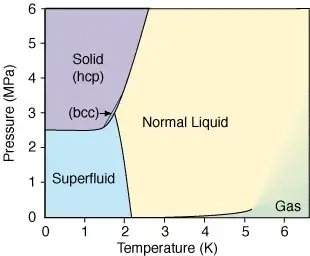Intergalactic space is 2.7K (https://en.wikipedia.org/wiki/Outer_space) Interstellar space is a little warmer. My understanding is that these will decrease over time.
The phase diagrams of helium I can find vary a little bit; eg
but they all show a superfluid state at 0 pressure and a sufficiently low temperature. (Helium 4 at 2.17K (http://ltl.tkk.fi/research/theory/helium.html)
This suggests that eventually, the helium in the intergalactic, and later, the interstellar medium will condense.
My questions:
- Is this prediction accurate?
- What effect will this have on someone observing space at that time?
- What other interesting effects would this have?
